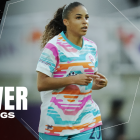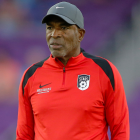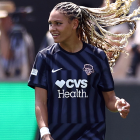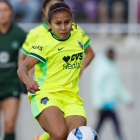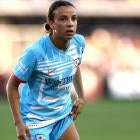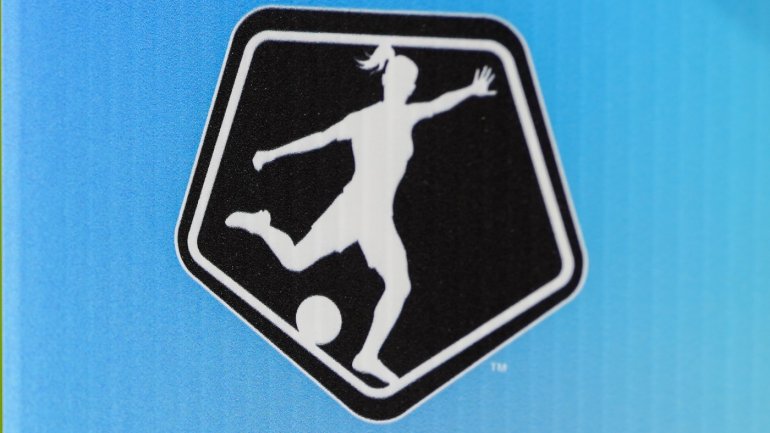
The NWSL has filed an application with U.S. Soccer to launch a Division II league in 2026 with the intention of furthering player development, marking the latest development in the evolving lower-league club landscape in women's soccer in the United States.
In documents obtained by CBS Sports, the application was filed on April 1 with a six-page letter signed by NWSL commissioner Jessica Berman submitted to U.S. Soccer CEO and secretary general JT Batson. In the letter, Berman likens the proposed Division II league to the minor-league baseball system, writing that it is "imperative that NWSL creates a robust pipeline for world-class athletes to fuel the [existing Division I league's] explosive growth." The Division II league is described as a transitional space between the college game and the professional game, one where young players can experience the "technical, tactical, and mental demands" of top flight soccer.
The NWSL has eight affiliated teams from its existing Division I league lined up for the inaugural season of the Division II league -- Bay FC, Kansas City Current, North Carolina Courage, NJ/NY Gotham FC, Orlando Pride, Racing Louisville, Seattle Reign and the Washington Spirit. Those Division II teams are slated to play at the same stadiums that the corresponding Division I teams play in and will take part in a traditional, double round-robin league where they play each team twice – once at home, once away. There will also be playoffs at the end of the 14-game regular season, with the No. 1 team facing the No. 4 team and No. 2 taking on No. 3. The winners of those games will then face off in the championship match.
The league confirmed the proposal in a following statement to CBS Sports: "The National Women's Soccer League has formally submitted an application and supporting documentation for a new Division II league to the United States Soccer Federation. As a global leader in the women's soccer landscape both on and off the pitch, the NWSL and its member clubs are committed to growing our sport in meaningful ways. The demand for professional soccer has never been higher. We look forward to working to build a strong foundation for future generations of players, officials and coaches and ensure the continued advancement of the women's game."
By enlisting existing NWSL teams, the Division II league meets or exceeds many of U.S. Soccer's criteria. The federation requires at least six teams in the first year of a Division II league and eight in year three, while 50% of the teams need to be in a metropolitan area with a population of 500,000-plus and stadium capacity needs to be at least 2,000. Each of the eight teams that are listed for the inaugural season of the NWSL's Division II league exceed both the population and stadium requirements.
All Division I teams are expected to form an affiliated second-tiered team within the first four years, a point in which the NWSL will have at least 16 teams – expansion teams in Boston and Denver will have their inaugural seasons in the NWSL next year. Teams that are unaffiliated with the NWSL will also be welcome to join the Division II league at some point.
The second tier will also serve as a space for clubs to build roster depth with the college draft now abolished, develop a pathway for player development as well as a place for injured players to feature in rehabilitation games to transition back into game shape before being reassigned to the Division I team. The same can be applied for coaches, referees and front office staff to hone their own skill sets. The NWSL also identifies the Division II league as "a testing ground for creative marketing strategies to grow the fan base of the women's game."
Additionally, these second division teams would be able to play international exhibitions against teams from outside the league, as well as participate in any international tournaments that the clubs might qualify for.
"This really is about developing the path from the youth levels of the game to the professional level." 👏@pcattry gives us the scoop on the @NWSL's newly proposed Division II League ⚽️ pic.twitter.com/wPcqFFD9vI
— Attacking Third (@AttackingThird) April 25, 2025
The ever-changing women's soccer pyramid
The Division II is modeled to serve as a reserve league, which is fairly common across the sports landscape. The NWSL cited baseball as an example, but can also pull from others in the soccer landscape – most MLS teams have a youth-focused team in MLS Next Pro, which is a third-tier league in the U.S. men's soccer pyramid. There is a similar setup in Europe, where many clubs have reserve teams that also play in lower leagues.
While that template for rising prospects to become successful professionals has been part of the global sporting landscape for some time, it is less common in women's sports because of historic underfunding. There is not currently an official Division II women's soccer league in the U.S., though the WPSL Pro announced plans just last week to launch as a Division II league. WPSL Pro is backed by the Women's Professional Soccer League, an amateur organization that originally intended for their new league to be classified as Division III. That announcement came not only with an upgraded status, but also new backing from Cleveland Soccer Group, which previously contended to win an NWSL expansion team.
The WPSL Pro, which also plans to start play in 2026, is currently awaiting sanctioning from U.S. Soccer and would rival the NWSL Division II league if both get the all-clear. It is not unprecedented for U.S. Soccer to sanction multiple leagues in the same division – the USL and the now-defunct NASL both shared Division II status at one point in the men's soccer pyramid, while the women's soccer pyramid currently have two Division I leagues, the NWSL and the USL Super League. The USL also plans to launch USL Division One in 2027, a second Division I league in the men's pyramid while MLS already has that designation.
Youth development: The next frontier
The NWSL is now in a period of rapid development driven by the increased attention and investment in women's sports and has used that momentum to make major updates to player recruitment rules like an increase in international roster spots and the abolition of the college draft. The resources that are now available to the league and its teams also allows stakeholders to address longstanding issues around player development, something commissioner Berman teased at NWSL Media Day in January.
"The resources that our clubs need to be able to make their scouting processes more sophisticated, it's created really important dialogue at our board level about investing the path to pro, which I think is going to be the next chapter of this league's growth," Berman said. "It sort of goes hand-in-hand with the idea of not having a draft and having full free agency that you need to shore up the foundation of your strategy to bring talent into the league and we have ideas and plans about how we're going to phase that into the growth of the league and this country has a tremendous amount of talent, more talent than any other country in the world, and we think there's a huge opportunity to use this as a catalyst for investment in youth."
Several different stakeholders across the women's soccer landscape have taken an increased interest in ensuring avenues exist for young players to turn professional in recent months. The list includes U.S. women's national team head coach Emma Hayes, who is beginning to use the U-23 team as a reserve team of sorts for the senior team, and to a greater extent Michele Kang, the billionaire owner of the Washington Spirit who made a $30 million donation to U.S. Soccer in November focused on girls' and women's programs.
Fans can watch select NWSL regular season matches across CBS, CBS Sports Network, Paramount+, and CBS Sports Golazo Network.
![[object Object] Logo](https://sportshub.cbsistatic.com/i/2020/04/22/e9ceb731-8b3f-4c60-98fe-090ab66a2997/screen-shot-2020-04-22-at-11-04-56-am.png)








